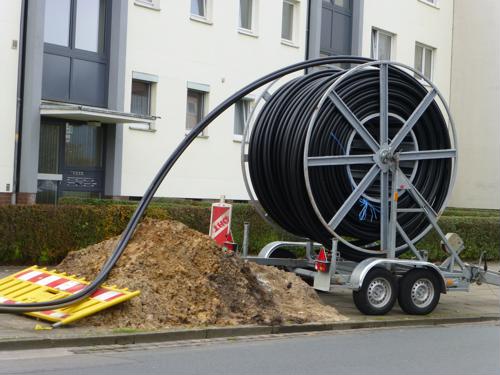
FTTx all over - Considering the implications of fiber in different geographical regions
By Max BurkhalterAugust 28, 2016
Implementing fiber-to-the-premises networks requires vastly different strategies depending on where the system is being installed. Planning effectively for the specific area where the system is being rolled out can accelerate deployment and ease the process of driving profitability from the network. Careful planning and strategic use of tools like media converters can ease deployment regardless of where a telecom is implementing the network, and fiber-optic cabling deployments can remain relevant regardless of where a telecom is considering construction.
While specific geographic issues such as terrain, elevation and weather conditions are highly relevant, population density is particularly influential on how fiber should be deployed. Planning specifically for urban, suburban and rural areas is especially essential for telecoms.
"Population density is particularly influential on how fiber should be deployed."
FTTx considerations in cities
Cities would, on the surface, seem like ideal locations for FTTx. They boast high population densities, feature a wide range of commercial and industrial organizations that would likely be willing to pay for services and even have local government bodies with a large enough constituent base to demand high-performance web services. This all adds up to a great environment for FTTx profitability. However, cities also present a wide range of unique challenges, including:
- An extremely challenging construction environment in which telecoms must contend with constantly-busy streets that make it difficult to dig new trenches when needed.
- Challenges getting fiber to specific housing and business units as many types of fiber are too rigid to handle these environments.
- Cluttered property lines that force telecoms to negotiate with a variety of parties when working on projects.
- Existing infrastructure that makes any network expansion extremely difficult without pulling out older cables or using creative methods of making space for wiring.
- Old buildings with large amounts of brick, plaster or concrete walls instead of drywall or sheetrock that would allow for easier cable installation.
These factors add complexity to any FTTx deployment in urban areas, but new technologies and methodologies can address such challenges, at least to some extent, moving forward. These include:
- Micro-trenching- a method of building short, narrow trenches for cable runs to buildings. While these accelerate projects dramatically by easing construction costs and challenges, they are not an option in all environments, and may not be permitted in all circumstances because the trench would leave the cable in such a shallow, exposed area.
- Bend-resistant fiber-optic cabling has emerged in recent years as a key tool in enabling fiber to be deployed more easily in multi-unit dwellings.
- Cost-efficient, high-quality media converters ensure projects remain cost efficient even when signal conversion is needed for a large number of units.
Innovative forms of cabling and construction are making FTTx deployments easier in urban areas, giving telecoms a valuable opportunity to monetize the technology.
FTTx in the suburbs
Suburbia is a natural hotbed for FTTx deployments as it offers a rare combination of relatively dense populations and high household incomes, but with just enough space for easy cable runs that connect homes and businesses to the network. However, there are still some challenges associated with suburban regions. They include:
- Building middle-mile cables out in towns not yet reached by such infrastructure or to reach new housing developments or similar construction that needs to be connected to your primary network.
- Deciding between running cables alongside power lines, which may be overloaded with infrastructure as is, or to deal with expensive construction to dig trenches to homes and businesses.
- Getting customers to buy into services based on fiber-optic networks when they may already have access to robust internet services.
Fiber-to-Ethernet media converters resolve inherent compatibility challenges between fiber infrastructure being deployed and copper systems already in homes. One increasingly common solution, however, is to roll out new cable alongside construction to take advantage of the time when ground is already dug up and streets are either not in place yet or are already disrupted to ease the installation process.

Suburbs present numerous opportunities for FTTx deployment.
FTTx in rural areas
Building fiber to homes and businesses is often not a viable option in rural regions because the distance between buildings combines with the low population density to make it an expensive endeavor with limited returns. However, there are a few options for fiber implementation that can become profitable in some rural areas:
- Implementing fiber-to-the-node. Building out fiber to nodes and then running high-performance copper to individual homes and buildings is generally less expensive, but still provides for high-quality internet in areas where the population isn't particularly dense.
- Rolling fiber out to central locations. Many rural areas still have a downtown where businesses, government facilities, some homes and schools are located. As fiber costs decline, the potential benefits of an FTTx rollout to these areas can be profitable under the right circumstances.
- Deploying fiber to reach radio signal towers or mobile base stations. For a long time, satellites have served rural communities looking for high-performance internet services. As mobile networks become more powerful, telecoms can use fiber-optic cabling to establish new radio signal towers and base stations to expand service portfolios with wireless broadband services.
Maximizing the value of FTTx systems
Households and businesses are increasingly demanding high-performance network solutions. Telecoms can meet these expectations through strategic FTTx deployments. Whether an internet service provider is hoping to deploy services in a large apartment building, get ahead in a competitive suburban environment or reach new customers in a rural area, there are ways to deploy fiber to maximize revenue potential.
Perle has an extensive range of Managed and Unmanaged Fiber Media Converters to extend copper-based Ethernet equipment over a fiber optic link, multimode to multimode and multimode to single mode fiber up to 160km.



